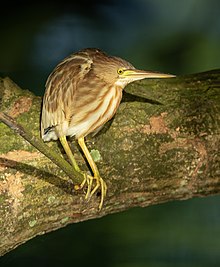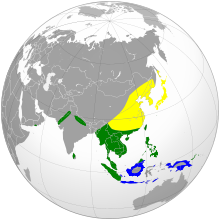| Yellow bittern | |
|---|---|

| |
| Conservation status | |
 Least Concern (IUCN 3.1) | |
| Scientific classification | |
| Domain: | Eukaryota |
| Kingdom: | Animalia |
| Phylum: | Chordata |
| Class: | Aves |
| Order: | Pelecaniformes |
| Family: | Ardeidae |
| Genus: | Botaurus |
| Species: | B. sinensis |
| Binomial name | |
| Botaurus sinensis (Gmelin, JF, 1789) | |

| |
| Range of B. sinensis Breeding range Year-round range Nonbreeding range | |
The yellow bittern (Botaurus sinensis) is a small bittern. It is of Old World origins, breeding in the northern Indian Subcontinent, east to the Russian Far East, Japan and Indonesia. It is mainly resident, but some northern birds migrate short distances. It has been recorded as a vagrant in Alaska and there is a single sighting in Great Britain, from Radipole Lake, Dorset on November 23, 1962 – however, the British Ornithologists' Union has always considered this occurrence to be of uncertain provenance and currently it is not accepted onto the official British List. This species was formerly placed in the genus Ixobrychus.
Taxonomy
The yellow bittern was formally described in 1789 by Johann Friedrich Gmelin in his revised and expanded edition of Systema Naturae. He placed it with the herons, cranes, storks and bitterns in the genus Ardea and coined the binomial name Ardea sinensis. Gmelin based his description on the "Chinese heron" that had been included by the English ornithologist John Latham in his multi-volume work A General Synopsis of Birds. Latham based his description on a collection of Chinese drawings. The yellow bittern was formerly placed in the genus Ixobrychus. A molecular phylogenetic study of the heron family Ardeidae published in 2023 found that Ixobrychus was paraphyletic and to create monophyletic genera, Ixobrychus was merged into the genus Botaurus that had been introduced in 1819 by the English naturalist James Francis Stephens. The genus name Botaurus is Medieval Latin for a bittern. The specific epithet sinensis is Modern Latin meaning "China". The species is monotypic: no subspecies are recognised.
Description
The yellow bittern is a small species at 36 to 38 cm (14 to 15 in) in length, with a short neck and longish bill. It has yellow green legs, an ivory bill (darker on top), a short black tail and yellow irises. The male of the species has a dark cap, chestnut head and neck, with a uniformly dull yellow body above and buff below. The female's cap, neck and breast are streaked, with a rufous hindneck and upper back and streaked dark red brown and buff under parts. The juveniles of the species resemble the female but is more boldly streaked, brown on its head and back, and mottled with buff above.
Distribution and habitat

Yellow bittern's are found in fresh water marshes and swamps. It nests in small constructed platforms of reeds or twigs in the vegetation of reed beds or in trees and shrubs adjacent to or above water. They lay four to six pale blue-green eggs.
Behaviour and ecology
| This section does not cite any sources. Please help improve this section by adding citations to reliable sources. Unsourced material may be challenged and removed. (February 2024) (Learn how and when to remove this message) |
Yellow bitterns feed on a variety of insects, fish, amphibians, crustaceans and molluscs.
Conservation
The yellow bittern is protected under the Migratory Bird Treaty Act of 1918.
Gallery
-
 1)Parent locates child birds without chirp (Chiba pref. Japan)
1)Parent locates child birds without chirp (Chiba pref. Japan)
-
 2)Child birds noticed parent then exit from thicket
2)Child birds noticed parent then exit from thicket
-
 3)Feeding to child birds
3)Feeding to child birds
References
- BirdLife International (2016). "Ixobrychus sinensis". IUCN Red List of Threatened Species. 2016: e.T22697303A93606843. doi:10.2305/IUCN.UK.2016-3.RLTS.T22697303A93606843.en. Retrieved 25 October 2021.
- Gmelin, J. F. (1789). Systema naturae per regna tria naturae : secundum classes, ordines, genera, species, cum characteribus, differentiis, synonymis, locis (in Latin). Vol. 1, Part 2 (13th ed.). Lipsiae : Georg Emanuel Beer. pp. 642–643.
- Latham, J. (1785). A General Synopsis of Birds. Vol. 3, Part 1. London: Printed for Leigh and Sotheby. p. 99.
- Hruska, J.P.; Holmes, J.; Oliveros, C.; Shakya, S.; Lavretsky, P.; McCracken, K.G.; Sheldon, F.H.; Moyle, R.G. (2023). "Ultraconserved elements resolve the phylogeny and corroborate patterns of molecular rate variation in herons (Aves: Ardeidae)". Ornithology: ukad005. doi:10.1093/ornithology/ukad005.
- ^ Gill, Frank; Donsker, David; Rasmussen, Pamela, eds. (August 2024). "Ibis, spoonbills, herons, Hamerkop, Shoebill, pelicans". IOC World Bird List Version 14.2. International Ornithologists' Union. Retrieved 20 August 2024.
- Chesser, R.T.; Billerman, S.M.; Burns, K.J.; Cicero, C.; Dunn, J.L.; Hernández-Baños, B.E.; Jiménez, R.A.; Johnson, O.; Kratter, A.W.; Mason, N.A.; Rasmussen, P.C.; Remsen, J.V.J. (2024). "Sixty-fifth Supplement to the American Ornithological Society's Check-list of North American Birds". Ornithology. 141 (3): ukae019. doi:10.1093/ornithology/ukae019.
- Jobling, James A. (2010). The Helm Dictionary of Scientific Bird Names. London: Christopher Helm. pp. 75, 357. ISBN 978-1-4081-2501-4.
- Silva Wijeyeratne, Gehan de (2008). A photographic guide to birds of Sri Lanka. Internet Archive. London : New Holland. ISBN 978-1-84773-318-4.
- ^ "Ixobrychus sinensis, Yellow bittern". Thai National Parks. Retrieved 2024-04-01.
- ^ "HeronConservation » Yellow Bittern". Retrieved 2024-04-01.
- Phillipps, Quentin; Phillipps, Karen (2010-01-07). Phillipps Field Guide To The Birds Of Borneo. John Beaufoy Publishing. p. 60. ISBN 978-1-906780-10-4.
{{cite book}}: CS1 maint: date and year (link) - ^ Pratt, H. Douglas (Harold Douglas) (2008). The birds & bats of Palau. Internet Archive. Honolulu, HI : Mutual Pub. pp. 164–165. ISBN 978-1-56647-871-7.
- "Yellow Bittern". Birds of Singapore. 2016-01-09. Retrieved 2024-04-01.
- ^ "Yellow Bittern". Animalia. Retrieved 2024-04-01.
- ^ "Yellow Bittern (Ixobrychus sinensis) – Planet of Birds". Retrieved 2024-04-01.
- "List of Birds Protected by the Migratory Bird Treaty Act (2023) | FWS.gov". www.fws.gov. 2020-04-26. Retrieved 2024-04-01.
- "10.13 List of Birds Protected by the Migratory Bird Treaty Act". National Archives Code of Federal Regulations. Retrieved 2024-04-01.
| Taxon identifiers | |
|---|---|
| Ixobrychus sinensis |
|
| Ardea sinensis | |